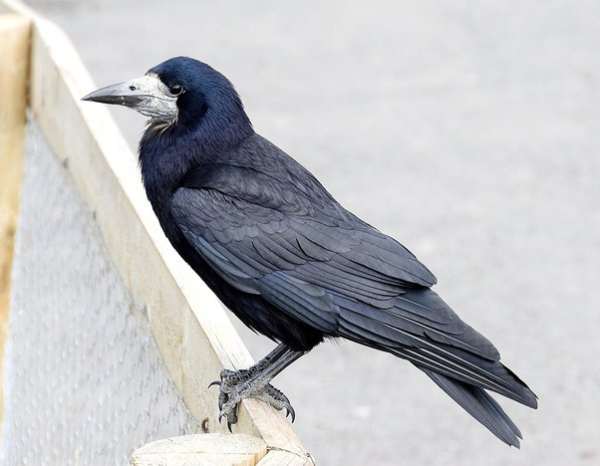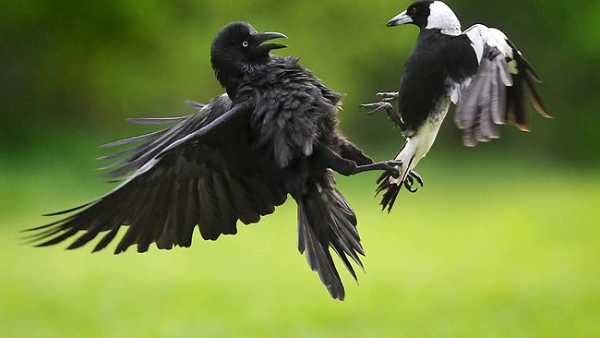Crows vs Magpies. They are both birds that are easily recognizable due to their distinctive appearances. Both birds are also known for being very adaptable, and they can be found in a variety of different habitats. One similarity between magpies and crows is that they are both considered to be pests by many people.
This is because both birds enjoy eating corn, seeds, and other crops. However, even though magpies and crows have many similarities, there are also some differences between these two types of birds.
In this article, We will talk about what makes magpies and crows different, such as who is bigger and their appearance. We’ll also find out how they build their nests and where they are built. We’ll also discover which of the two acts as a protector to keep the chick safe. Stay tuned to this Article to learn amazing facts about crows vs magpies.
Table of Contents
Crow

Crows are dark-coloured birds that are known for their intelligence and adaptability. In the United States, there are three species of crow: the American crow, the fish crow, and the Northwestern crow. The American crow is the most widespread, being found in most states, while the Northwestern crow is confined to the northern Pacific coast of Washington state.
Fish crows look identical to American crows but are only found along the eastern and southern coastlines. All three species are highly intelligent and have been known to use tools, learn new behaviours from one another, and even communicate with humans.
Magpies

Magpies are known for their intelligence, and they are often considered to be pests because of their fondness for shiny objects. There are two species of magpies that reside in the continental United States: the black-billed magpie (Pica hudsonia) and the yellow-billed magpie (Pica nuttalli). The black-billed magpie is found in northwestern regions of the country and has a long tail, black-and-white body, and blue-tinged wings. The yellow-billed magpie is found in parts of California and looks similar to the black-billed magpie except for the beak colour.
CROWS VS MAGPIES: Main Differences
1. Tails of Different Lengths
The length of their tails is one of the simplest ways to differentiate them. Crows have shorter tails that range in length from 16 to 21 inches, matching the length of their bodies. One of the distinguishing characteristics of magpies is their larger tails.
A magpie is roughly the same size as a crow, measuring between 17 and 23 inches in length. Even, if you see both birds side-by-side, you can distinguish one from the other by looking at their tails.
2. Feather Colors Difference
Another way to distinguish between crows and magpies is by the colour of their feathers. Crows have dark black feathers, with black beaks and legs. Magpies, on the other hand, have black feathers tinged with blue, and white feathers on their breasts and sides. The black feathers of a crow are drab and lacklustre, while the black feathers of a magpie are glossy and shining.
3. Wingspan Size Difference
One of the most obvious is wing length – crows have much longer wings, measuring 34 to 39 inches compared to the 22 to 24-inch wingspans of magpies. This difference is reflected in their flight patterns – crows have a more powerful and direct flight, while magpies tend to be more agile and graceful in the air. You may observe the spectacular display of magpies’ white feathers and rounded wings while they are in flight. However, the wings of crows are broader and feature very few bends.
4. Body Mass Difference
Magpies and crows also have drastically different body masses. While the weight of a magpie merely varies from 5 to 7 ounces, that of a crow can vary from 11 to 22 ounces.

5. Different “coos”
Magpies are songbirds, and their calls are typically high-pitched and melodious. On the other hand, crows have hoarse, grating coos that are often followed by a clunking sound. This difference in vocalization is due to the fact that crows lack the syrinx, a structure in the throat that allows birds to produce complex vocalizations. Hence, crows are unable to sing like other birds, and their calls tend to be much simpler.
6. Flight Speed Difference
Crows are much faster, reaching speeds of 30 to 60 miles per hour. They are also more agile, and while attacking they can go up to 70 miles per hour. In contrast, magpies have a more leisurely flight style, with speeds of 10 to 15 miles per hour. But, they can extend their flight to cover longer distances, up to 30 miles while catching prey.
7. Reproduction Habit Difference
Both birds reach sexual maturity at around two years old, crows typically don’t start breeding until they’re four. This is because they tend to stay with their parents longer in order to receive care and learn important skills. In contrast, magpies often begin breeding as soon as they reach maturity. Also, crows usually only mate with one partner during the breeding season, while magpies often mate with multiple partners. This difference is likely due to the fact that crows form stronger bonds with their chosen mates.

8. Size of Eggs Difference
Different species of birds lay different-sized eggs. Same in the case of, crows and magpies both lay eggs that are different in size. Crow eggs are typically larger than magpie eggs. Crows typically lay 4 to 8 eggs per clutch and the size of a crow egg can vary from 2 inches to 1.6 inches, while the size of a magpie egg is usually less than an inch.
Although the colour of the eggs is usually the same, it is easy to distinguish them by their size. In general, crow eggs are larger and more round than magpie eggs. Magpie eggs, on the other hand, are smaller and more oval in shape.
9. Nest Structure Difference
One key difference between these two types of birds is the way they build their nests. Crows generally make simple nests using branches, twigs, or even scraps of cloth. Magpies, on the other hand, build much more intricate structures that resemble fortresses complete with walls and canopies. This fortress-like design helps to protect their young from intruders and predators.
Magpies are known to be very protective of their nests and will often attack if they feel threatened. Crows, on the other hand, are more likely to abandon their nests if they feel threatened. Magpies build their nests in a way that makes them much more difficult for predators to access, while crows build their nests in a way that makes them more vulnerable to attack.
10. Superstitions Difference
Crows and magpies are linked to various superstitions depending on the culture, but generally speaking, crows are thought to bring bad luck and death. Crows are seen as omens of doom in many civilizations, and the black colour of their plumage is linked to witchcraft and the underworld. Thus, superstitious people frequently have a fear of crows and steer clear of them at all costs. Magpies, on the other hand, are typically seen as lucky animal emblems. Killing a magpie is believed to bring bad luck in Chinese culture where they are seen to provide happiness.
FAQs
Do magpies fight with crows?
Especially during the breeding season, when birds are protecting their territory, nesting sites, or maybe a food source, this type of behaviour does occur.
Who is smarter a crow or a magpie?
The American Crow
Do crows, not like magpies?
Crows and magpies frequently engage in confrontational interactions, with crows typically being the aggressors.
What are magpies scared of?
CDs or plastic bottles half-full strung from trees to frighten away predators. The way the sun glints from the surface bothers magpies.
Which bird has the highest IQ?
The Kea
Final Words
Though both crows and magpies look similar, there are several differences between them. Crows are larger than magpies, and they have a more streamlined appearance. Magpies also have a distinctive crest on their head, while crows do not. In terms of behaviour, crows are more likely to be seen in pairs or small groups, while magpies typically travel in flocks. Lastly, crows are known for their raucous calls, while magpies are less vocal birds. Therefore they may look similar at first glance, but crows and magpies are actually quite different.
References:
https://www.theguardian.com/environment/2012/mar/23/sandy-bedfordshire-magpie-versus-crow
https://www.nationalgeographic.co.uk/animals/2018/03/why-ravens-and-crows-are-earths-smartest-birds
https://community.rspb.org.uk/wildlife/f/wildlife-questions/37374/crows-regularly-harrassing-magpies-whilst-they-are-constructing-their-nest

Zahra Makda
Growing up enjoying the beauty of my village, a good passion for nature developed in me from childhood. Following my passion for the natural world, I have chosen zoology for my graduation, during my undergraduate degree, I participated in many nature trails, bird watching, rescues, training for wildlife conservation, workshop, and seminars on biodiversity. I have a keen interest in invertebrate biology, herpetology, and ornithology. Primary interests include studies on taxonomy, ecology, habitat and behavior.









